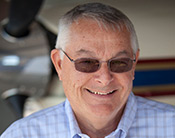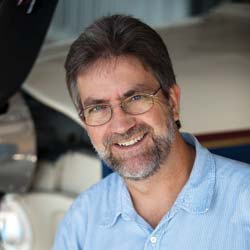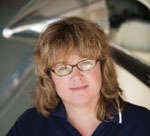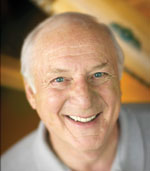Hangar Talk
The story behind the story
 There was more information about flying in the Yellowstone and Grand Teton national parks than we could cram into the magazine, even when devoting 10 pages to the adventures of Senior Editor Al Marsh and Senior Photographer Mike Fizer ( “ Epic Flights: Flying Yellowstone and ‘The Grand,’”). For example, Andy Breffeilh, owner of the Wyoming Balloon Company offering early morning flights near Grand Teton National Park, lives in the home originally built by singer Robert Goulet and his wife, Carol Lawrence, a world-class singer, actress, and dancer who first gained fame as Maria in the Broadway musical, West Side Story. Perched on a mountaintop, which Marsh and Fizer visited, Breffeilh can see his takeoff and landing area from miles away by just stepping out the door. During ballooning season, his mornings begin at 4:30 a.m. Out of season, he mans his snowplow so that he can get down the mountain to the main highway to Jackson, Wyoming—he’s quite a storyteller. And he’s proud to have his niece, Margaret Breffeilh, starting her own balloon-ride company this season after getting her commercial certificate shortly after Marsh and Fizer visited.
There was more information about flying in the Yellowstone and Grand Teton national parks than we could cram into the magazine, even when devoting 10 pages to the adventures of Senior Editor Al Marsh and Senior Photographer Mike Fizer ( “ Epic Flights: Flying Yellowstone and ‘The Grand,’”). For example, Andy Breffeilh, owner of the Wyoming Balloon Company offering early morning flights near Grand Teton National Park, lives in the home originally built by singer Robert Goulet and his wife, Carol Lawrence, a world-class singer, actress, and dancer who first gained fame as Maria in the Broadway musical, West Side Story. Perched on a mountaintop, which Marsh and Fizer visited, Breffeilh can see his takeoff and landing area from miles away by just stepping out the door. During ballooning season, his mornings begin at 4:30 a.m. Out of season, he mans his snowplow so that he can get down the mountain to the main highway to Jackson, Wyoming—he’s quite a storyteller. And he’s proud to have his niece, Margaret Breffeilh, starting her own balloon-ride company this season after getting her commercial certificate shortly after Marsh and Fizer visited.
 Just about every pilot, at some point in time, has made a purchase from Sporty’s Pilot Shop. For some, Sporty’s is a source of training courses; for others, the place to go for pilot supplies. Well, Sporty’s turns 50 years old this year ( “A Half-Century Training Legacy,” )—a significant achievement for any business, and especially for one in the aviation industry. Ever wonder how your orders are fulfilled? “If you’ve ever been in the big UPS air-freight hub in Louisville at midnight to see all those overnight packages arrive, change airplanes, and depart,” says Technical Editor Mike Collins, “the afternoon shipping push at Sporty’s warehouse in Batavia, Ohio, is similar—albeit smaller. It also takes place at a much more civilized time of day.”
Just about every pilot, at some point in time, has made a purchase from Sporty’s Pilot Shop. For some, Sporty’s is a source of training courses; for others, the place to go for pilot supplies. Well, Sporty’s turns 50 years old this year ( “A Half-Century Training Legacy,” )—a significant achievement for any business, and especially for one in the aviation industry. Ever wonder how your orders are fulfilled? “If you’ve ever been in the big UPS air-freight hub in Louisville at midnight to see all those overnight packages arrive, change airplanes, and depart,” says Technical Editor Mike Collins, “the afternoon shipping push at Sporty’s warehouse in Batavia, Ohio, is similar—albeit smaller. It also takes place at a much more civilized time of day.”
 Associate Editor Jill W. Tallman’s mother, Dorothy Wood, rode in a helicopter years before her daughter flew one for this month’s Challenges article ( “Challenges: Fling-Winging It,” ). “She suffered an aneurysm and was airlifted in an EMS helicopter from Easton, Maryland, to Johns Hopkins Hospital in Baltimore,” Tallman says. “The transport took less than a half-hour, but she remembered it and spoke of it often. I have no doubt that the EMS flight played a part in saving her life.” Tallman’s introduction to helicopter flying, thankfully, was a lot more upbeat. “Even though hovering seems practically impossible the first time you try it, there’s something about it that makes you want to get back out there and do it again. It’s pretty habit-forming,” she says.
Associate Editor Jill W. Tallman’s mother, Dorothy Wood, rode in a helicopter years before her daughter flew one for this month’s Challenges article ( “Challenges: Fling-Winging It,” ). “She suffered an aneurysm and was airlifted in an EMS helicopter from Easton, Maryland, to Johns Hopkins Hospital in Baltimore,” Tallman says. “The transport took less than a half-hour, but she remembered it and spoke of it often. I have no doubt that the EMS flight played a part in saving her life.” Tallman’s introduction to helicopter flying, thankfully, was a lot more upbeat. “Even though hovering seems practically impossible the first time you try it, there’s something about it that makes you want to get back out there and do it again. It’s pretty habit-forming,” she says.
 There are a few golden rules in aviation that are presumably inviolate. One of them states that the pilot of a single-engine airplane who experiences total engine failure shortly after takeoff should always land straight ahead. Author Barry Schiff has been researching this subject for decades and has determined that there are times when it is wiser to reverse course than to dogmatically continue straight ahead irrespective of the circumstances ( “Technique: Unconventional Wisdom,” ). “There can be grave danger in reversing course,” Schiff says, “unless the pilot has practiced the turnaround maneuver, knows what is required to return safely to the airport, and has honed the necessary skill in the type of airplane in which such an engine failure occurs.”
There are a few golden rules in aviation that are presumably inviolate. One of them states that the pilot of a single-engine airplane who experiences total engine failure shortly after takeoff should always land straight ahead. Author Barry Schiff has been researching this subject for decades and has determined that there are times when it is wiser to reverse course than to dogmatically continue straight ahead irrespective of the circumstances ( “Technique: Unconventional Wisdom,” ). “There can be grave danger in reversing course,” Schiff says, “unless the pilot has practiced the turnaround maneuver, knows what is required to return safely to the airport, and has honed the necessary skill in the type of airplane in which such an engine failure occurs.”


